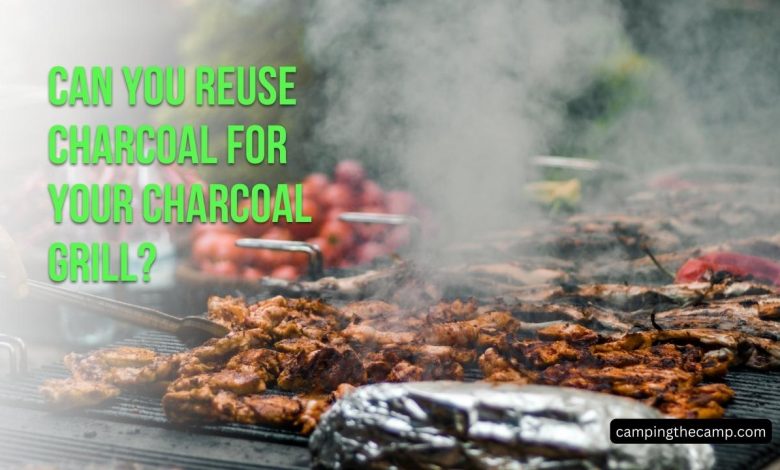Can You Reuse Charcoal for your Charcoal Grill?

For backyard grill masters, piles of expended charcoal leftover after grilling are a familiar sight. While the impulse may be to discard the burned briquettes after each use, much of the charcoal can actually be reused, saving you money. Relighting charcoal takes a bit more effort than using new, but comes with environmental benefits and significant cost savings that make it worth it.
However, there are right and wrong ways to reuse charcoal safely and effectively. To avoid subpar grilling and harmful chemicals, you need to understand proper briquette storage, when to throw it out, the best re-lighting methods, and how to tweak your grilling techniques for reused charcoal. We’ll cover all of this and more, with plenty of tips for economical, eco-friendly grilling!
Storing Used Charcoal Properly
First, it’s vital to store unused charcoal briquettes correctly between grilling sessions. To re-light charcoal easily later, follow these storage guidelines:
- Allow used charcoal to burn out fully after cooking, then let it cool completely before storage. Hot charcoal can start fires.
- Remove ash and debris before storing. Ash will reduce airflow and inhibit re-lighting.
- Place cooled briquettes in an airtight metal container like a bucket with a tight lid. This prevents moisture absorption.
- Store in a dry spot away from direct sun or rain, which can wet the charcoal.
- Only reuse lump charcoal up to 3 times. Briquettes with filler can be reused 4-5 times before losing effectiveness.
With proper closed storage, the charcoal will be protected and ready to be recycled for your next barbecue. Never store hot ash or charcoal!
Knowing When to Toss Charcoal
Relighting charcoal can work extremely well, but inevitably it will reach the end of its usefulness. Here are signs it’s time to throw it out and use new charcoal:
- Excessive Ash – More than 25% ash content makes charcoal difficult to light. Go ahead and replace it.
- Bad Odors – Reused charcoal can absorb food odors over time that get released during cooks. Toss it if smells are unpleasant.
- Lack of Heat Output – Charcoal that repeatedly won’t light or doesn’t burn hot enough should be discarded.
- Excessive Sparks and Popping – Pops of sparks are normal, but frequent hot sparks mean the charcoal is spent.
- Mold Growth – Wet, improperly stored charcoal may grow mold. Never use moldy charcoal.
Trust your senses. If the charcoal seems ineffective or off, it’s time for fresh stuff.
Relighting Charcoal for Reuse
Relighting charcoal requires a bit more effort than using new, but a few simple tricks will have it ready to cook again quickly:
- Remove ash and debris from cool used charcoal before reusing. Ash buildup inhibits airflow.
- Stack reused briquettes in your grill in a pyramid shape, allowing air flow through cracks.
- Use paraffin firestarter cubes directly on the charcoal to quickly ignite a hot fire.
- Leave the grill lid off at first while rekindling the charcoal, fanning it occasionally if needed.
- Once the charcoal is visibly ashed over with a light powdery gray coat, replace the lid to allow it to reach optimal cooking temp.
- Consider using an electric charcoal chimney starter to rekindle charcoal if having difficulty relighting manually.
Within 20-30 minutes, the charcoal should be ready for grilling again! It lights fastest if somewhat broken down with crumbly edges to increase surface area.
Grilling Strategies with Reused Charcoal
When cooking over reused charcoal, employ these strategies for best results:
- Let the charcoal rekindle for at least 20 minutes before grilling for good heat.
- Grill larger, longer-cooking items over reused charcoal rather than quick foods. Maintaining temps is harder.
- Opt for two-zone indirect grilling, with a hot zone for searing and a cooler zone to cook food through without burning.
- Keep the grill vents fully open to provide maximum airflow and temperature regulation.
- Occasionally sprinkle a bit of fresh charcoal over reused briquettes for an added heat boost.
While reused charcoal burns somewhat less controllably than fresh, with smart grilling methods you can still use it effectively. Now enjoy great tasting barbecue on a budget!
Safety Tips
While reusing charcoal is economical and often safe, always keep these precautions in mind:
- Never reuse charcoal briquettes containing lighter fluid, toxic chemicals, or other unknown substances. Use only plain charcoal.
- When relighting, allow charcoal to fully ignite and ash over before grilling to avoid chemical odors.
- Don’t let reused charcoal sit touching food for more than a few minutes, as it can release benzene and other volatile compounds.
- Ensure charcoal is completely cooled after grilling before reuse storage to prevent fires.
- Avoid excessive charcoal reuse, as it becomes less stable and prone to spark.
- Have a fire extinguisher handy any time you light charcoal.
With due caution, reused charcoal serves up big savings and keeps waste out of landfills. But always put safety first!
Troubleshooting Reused Charcoal Issues
If you follow the proper steps yet still struggle with rekindling old charcoal, here are some troubleshooting tips:
- Remove all ash buildup for optimal airflow.
- Stack charcoal loosely with plenty of air gaps.
- Use more firestarter cubes directly on briquettes.
- Try an electric charcoal chimney for faster, hotter lighting.
- Combine reused charcoal with some fresh briquettes for added heat.
- Ensure briquettes are fully cooled and dry after prior use before storage.
- Toss charcoal if excessively old, ash-filled, or contaminated.
With a bit of experimenting, you’ll master reusing charcoal effectively.
Frequently Asked Questions
How many times can you reuse charcoal?
Lump charcoal can typically be relit 2-3 times. Charcoal briquettes with fillers can be reused up to 4-5 times before needing replacement.
Does reused charcoal make food taste bad?
It shouldn’t, if stored properly between uses and allowed to fully re-ash over before cooking. Toss out oddly smelling charcoal.
Is it safe to cook over reused charcoal?
Yes, when using plain charcoal and allowing it to fully ignite again before grilling. Don’t reuse additive-containing briquettes.
Can you reuse both lump charcoal and briquettes?
Yes, both can be reused by following proper storage and re-lighting guidelines. Lump charcoal may last fewer reuses than briquettes with fillers.
Does relighting charcoal take longer than using new?
Yes, reused charcoal usually requires 20-30 minutes to rekindle fully before reaching grilling temperature. But it’s worth it for the savings!
The Savory Verdict
Reigniting charcoal for repeated grilling takes more time and care than using new, but comes with serious cost and environmental payoffs. Follow safe storage and relighting techniques, and those crusty black briquettes will fire up deliciously again. With the guidelines from this article, you can become an expert at reusing charcoal for maximum economy and reduced waste while still grilling up mouthwatering barbecue. Fire it up—your tastebuds, wallet, and the planet will thank you!
Conclusion
Used charcoal may seem ready for the trash after grilling, but it can often be reused effectively and safely with big benefits for your budget and the environment. While it requires proper storage and re-lighting methods, recycled charcoal performs nearly as well as new if you follow the recommendations in this guide. Now you have the knowledge for economical, eco-friendly grilling by reusing charcoal correctly. Give it a try—saving money while also reducing waste is always savory!




